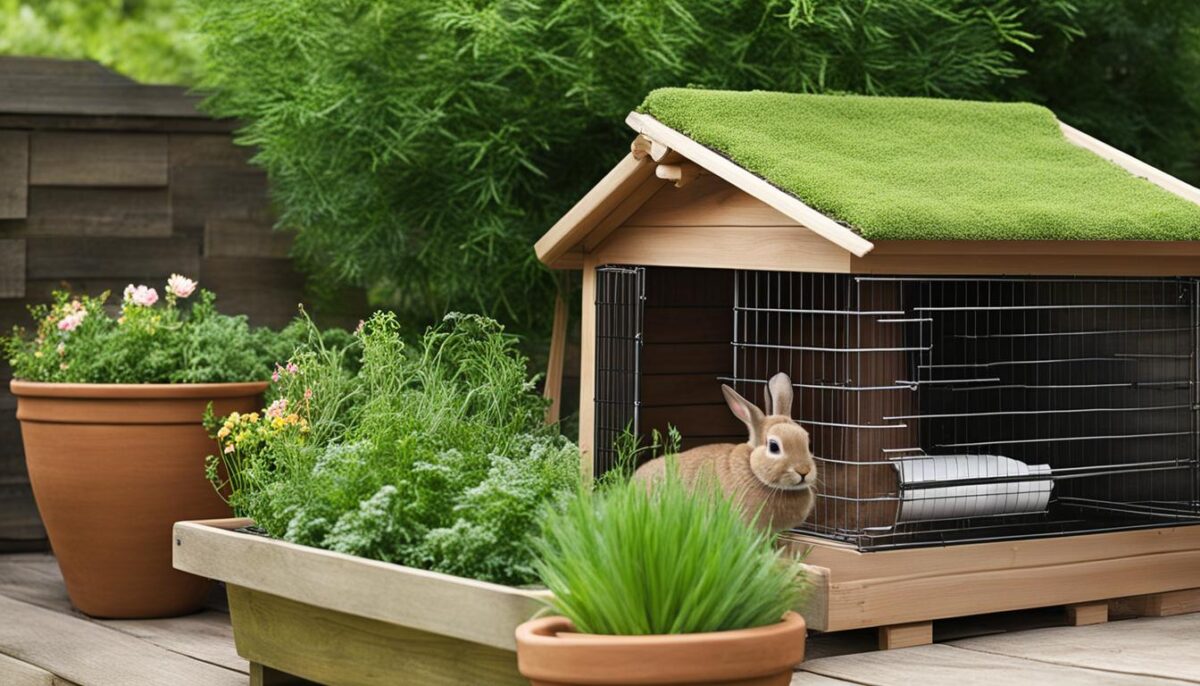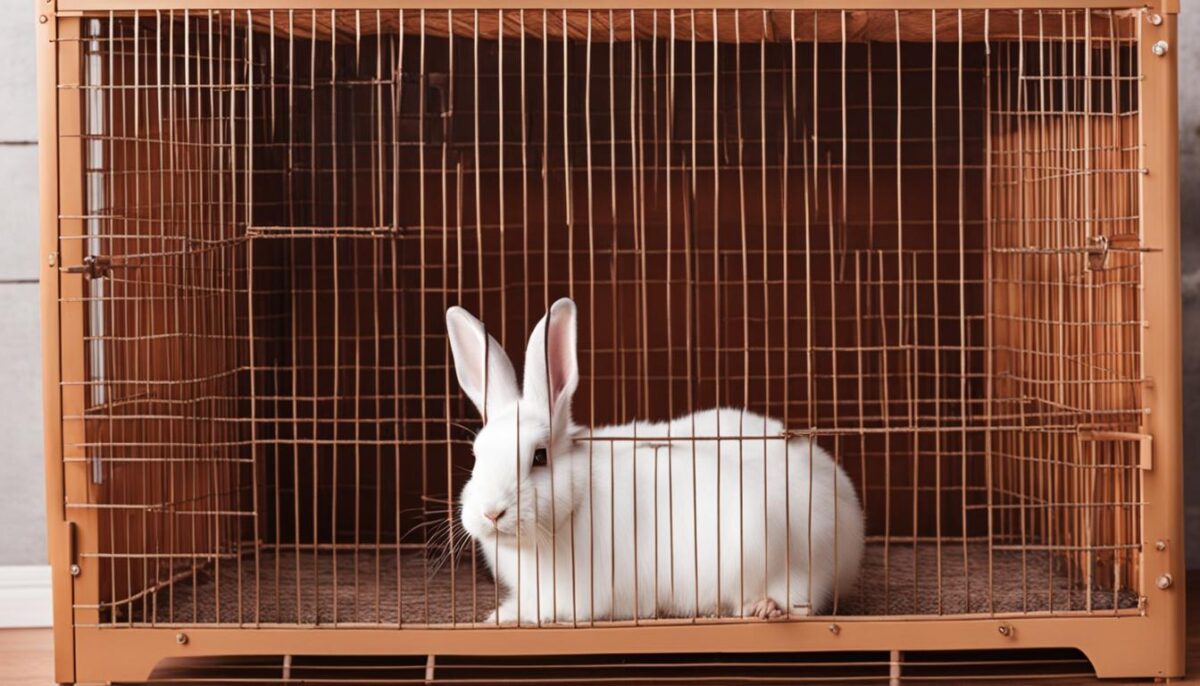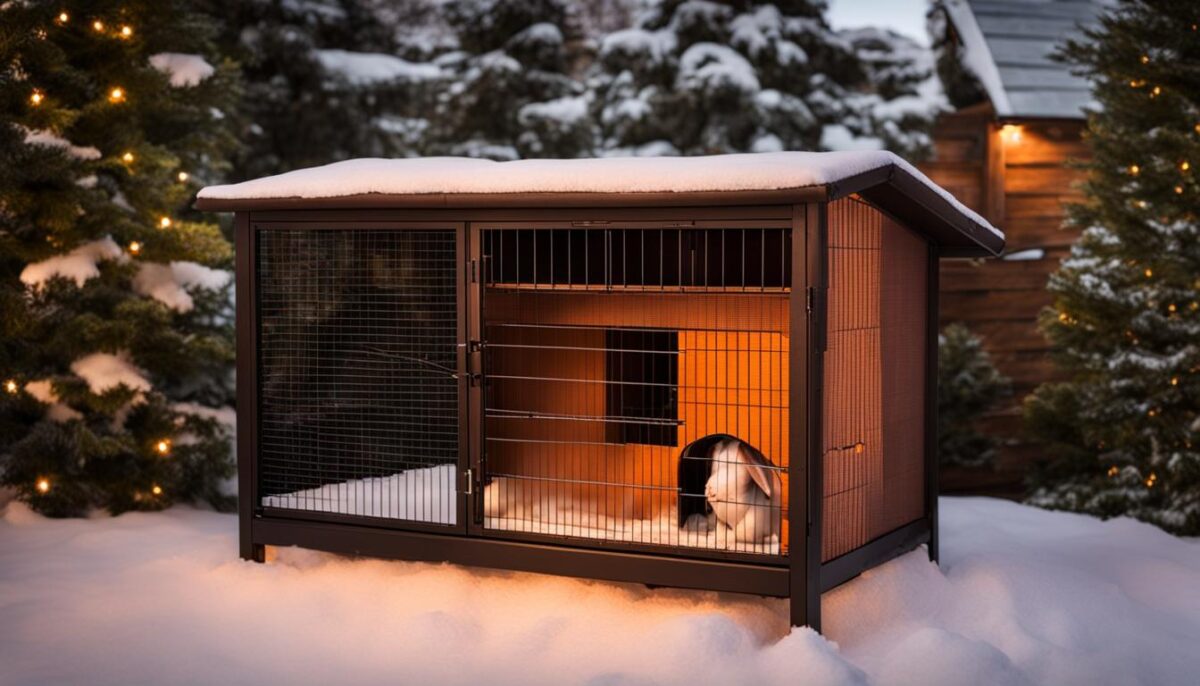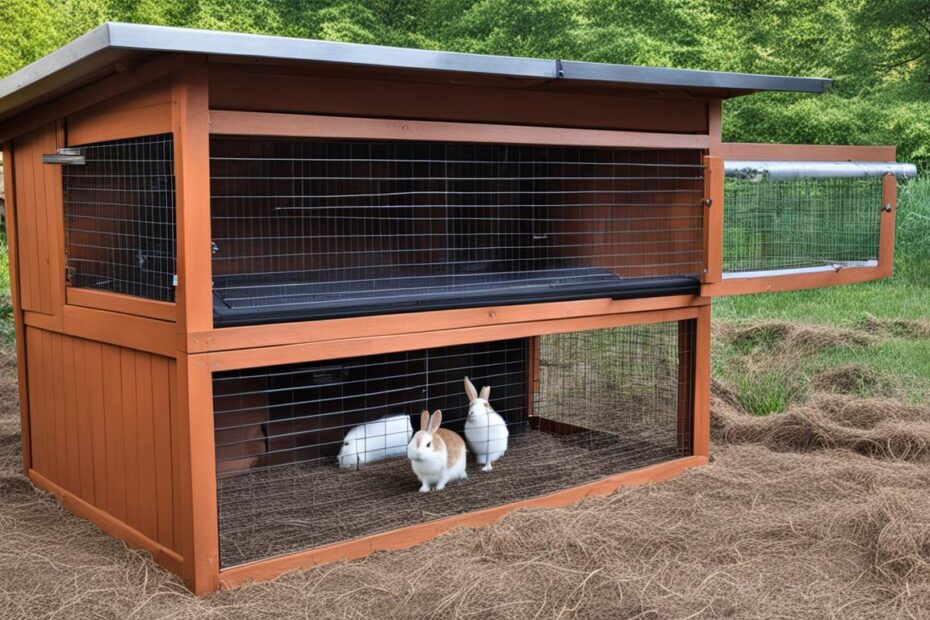If you house your rabbits in an outdoor hutch, it’s important to take measures to keep them warm and comfortable in colder temperatures. Some effective heating options for rabbit hutches include safe heat pads, heat lamps or tubular heaters, insulation, and moving the hutch to a warmer area. Investing in a well-designed and weather-protected hutch can also help keep your rabbits safe from the cold.
Key Takeaways:
- Ensure your outdoor rabbit hutch is equipped with a suitable heater to keep your rabbits warm and comfortable.
- Consider using safe heat pads that provide soothing warmth for up to 10 hours, or heat lamps and tubular heaters designed for outdoor pet spaces.
- Insulate the hutch using old tablecloths, blankets, and towels, and create a barrier against wind by using tarpaulin, cardboard, and newspaper.
- If possible, move the hutch to a naturally warmer location, such as a garage or shed, or position it to minimize exposure to wind and drafts.
- Investing in a well-designed and draft-proof hutch can provide better protection against the cold and ensure a comfortable living space for your rabbits.
Using Heat Pads to Keep Rabbits Warm
When it comes to providing a safe and effective heating solution for outdoor rabbit hutches, heat pads are a popular choice. These pads offer a cozy and warm spot for rabbits to snuggle up, helping them stay comfortable even in colder temperatures. One trusted brand is Snugglesafe, which offers microwavable heat pads specifically designed for rabbits. These pads provide up to 10 hours of safe and soothing warmth, making them an ideal option for overnight use.
Another great heat pad option is the Marunda Pet Heating Pad. This pad features a built-in dual control for adjustable temperatures, waterproof properties, and chew-resistant capabilities. With this pad, you can ensure that your rabbits are warm and comfortable while minimizing any potential risks. It’s important to note that heat pads are non-electrical, eliminating the risk of electrical dangers and providing an extra layer of safety for your furry friends.
Heat pads offer a simple and affordable heating solution for outdoor rabbit hutches, providing rabbits with a cozy spot to warm up and relax.
When using heat pads, it’s essential to follow the manufacturer’s instructions for heating and usage. Always check the pad’s temperature before placing it in the hutch to avoid any burns or discomfort for the rabbits. Additionally, make sure to position the heat pad in a secure and stable area of the hutch, away from any potential hazards or chewing opportunities.
By using heat pads in your rabbit hutch, you can ensure that your rabbits stay warm and comfortable throughout the colder months. These pads offer a safe and convenient option for providing the necessary warmth that outdoor rabbits need to thrive.
Table: Comparison of Heat Pads
| Brand | Features |
|---|---|
| Snugglesafe | Microwavable, up to 10 hours of warmth, non-electrical, safe and soothing |
| Marunda Pet Heating Pad | Built-in dual control, adjustable temperatures, waterproof, chew-resistant |
Using Heat Lamps and Tubular Heaters
When it comes to providing warmth for outdoor rabbit hutches, heat lamps and tubular heaters are popular choices. Heat lamps emit focused heat and can be hung above the hutch, ensuring a warm and cozy environment for the rabbits. However, it’s important to take precautions to prevent accidents. Make sure the wires are inaccessible to the rabbits and avoid placing the lamp too close to the hutch.
Tubular heaters are another effective option for heating outdoor rabbit hutches. These heaters are usually installed on a wall at a safe distance from the hutch to prevent any contact with the rabbits. The Akoma Hound Heater is a reliable and pet-safe tubular heater that comes with a thermostat for temperature control. It is also chew-resistant, ensuring the safety of your rabbits.
“Heat lamps and tubular heaters are commonly used to provide warmth in outdoor pet spaces.”
Both heat lamps and tubular heaters are suitable for providing sufficient warmth for outdoor rabbit hutches. The choice between them depends on your specific needs and hutch setup. Ensure that the heating devices are used with caution and that the welfare and safety of your rabbits are the top priority.

Table: Comparison of Heat Lamps and Tubular Heaters
| Features | Heat Lamps | Tubular Heaters |
|---|---|---|
| Installation | Hang above the hutch | Mounted on a wall |
| Safety | Ensure wires are inaccessible to rabbits; avoid placing too close to the hutch | Installed at a safe distance from the hutch; chew-resistant design |
| Temperature Control | Does not usually have a thermostat | Comes with a thermostat for precise temperature control |
| Focus of Heat | Emits focused heat directly below the lamp | Spreads heat evenly throughout the hutch |
| Ease of Use | Easy to hang and adjust | Simple installation and temperature control |
Insulating the Hutch for Added Warmth
Insulating the hutch is a cost-effective and essential step in keeping your rabbits warm during colder temperatures. Adding insulation materials can help retain heat and create a cozy environment for your furry friends. Here are some options for insulating the hutch:
- Old tablecloths, blankets, and towels: These materials can be used to create additional layers of insulation within the hutch. Fleece-lined and fluffy blankets are recommended as they offer extra warmth and comfort.
- External insulation: Tarpaulin, cardboard, and newspaper can be used to create a barrier against wind and cold. These materials can be attached to the exterior of the hutch to provide an additional layer of protection.
It’s important to ensure that the insulation materials stay dry to prevent dampness and cold. Regularly check the condition of the insulation and replace or reposition as needed.
Insulating the hutch is a cost-effective way to keep your rabbits warm and comfortable. By using materials such as blankets, towels, and tarpaulin, you can create an extra layer of insulation that helps retain heat and keep out the cold. It’s important to regularly check the condition of the insulation and ensure the materials stay dry to prevent any discomfort for your rabbits.
Table: Insulation Materials for Rabbit Hutch
| Insulation Materials | Benefits |
|---|---|
| Old tablecloths, blankets, and towels | – Provides extra layers of insulation – Offers warmth and comfort – Easy to replace and clean |
| Tarpaulin, cardboard, and newspaper | – Creates a barrier against wind and cold – Improves insulation efficiency – Affordable and readily available |
Moving the Hutch to a Warmer Location
During the colder months, one effective solution to keep your rabbits warm in their outdoor hutch is to move it to a naturally warmer area. This can provide better protection against the cold and help maintain a comfortable temperature for your furry friends. By positioning the hutch in a garage or shed, you can create a sheltered environment that minimizes exposure to the elements.
If moving the hutch indoors is not an option, it’s essential to position it strategically to block drafts and minimize wind exposure. By placing the hutch against a wall or using barriers to shield it from strong winds, you can help maintain a warmer and more comfortable atmosphere for your rabbits.
To ensure optimal warmth in the new location, consider using heating devices like tubular heaters or other suitable heating solutions. These devices can provide additional heat and help maintain a comfortable temperature inside the hutch. By combining the benefits of a warmer area with supplemental heating, you can create a cozy and safe environment for your rabbits during the winter months.
Upgrading to a Draft-Proof Hutch

Investing in a well-designed hutch that provides natural draft control is crucial for keeping rabbits warm. A draft-proof hutch prevents cold winds and rain from entering, creating a comfortable living space for your rabbits. One popular option is the Trixie Rabbit Hutch with Outdoor Run. This hutch offers draft-proof features, ensuring that your rabbits stay cozy and protected from the elements. It also includes a secure playpen area, allowing your rabbits to safely explore their surroundings.
A draft-proof hutch typically has a closed enclosure above floor level, which provides a sheltered area for rabbits to seek warmth. This design prevents drafts from entering the hutch, helping to maintain a consistent and comfortable temperature. By investing in a draft-proof hutch, you can ensure that your rabbits have a warm and inviting living space even during colder months.
When choosing a draft-proof hutch, consider factors such as insulation, ventilation, and overall durability. Look for hutch designs that minimize gaps and openings where cold air can seep in. Additionally, opt for hutch materials that are weather-resistant and can withstand the elements. These features will help create a cozy and energy-efficient environment for your rabbits.
| Benefits of a Draft-Proof Hutch | Considerations |
|---|---|
| Provides natural draft control | Choose a hutch with proper insulation |
| Offers a sheltered area for rabbits to seek warmth | Ensure proper ventilation for fresh air circulation |
| Prevents cold winds and rain from entering | Opt for weather-resistant materials |
| Creates a consistent and comfortable temperature | Select a durable hutch design |
“Investing in a well-designed and draft-proof hutch is essential to providing your rabbits with a warm and comfortable living space. By minimizing drafts and keeping out cold winds and rain, a draft-proof hutch ensures that your rabbits can thrive even during colder months.” – Rabbit Health & Wellness Magazine
Rabbit Hutch Heating Options and Weather Protection
When it comes to keeping your rabbits warm and protected in their hutch during colder weather, there are several heating options and weather protection strategies you can employ. By providing shelter from wind and rain, as well as implementing effective heating solutions, you can ensure the comfort and well-being of your furry friends.
Shelter from Wind and Rain
One way to protect your rabbits from the elements is by providing shields made of see-through plastic to cover the wire meshed front of the hutch. These covers offer protection from wind and rain, and can be rolled up to allow for proper ventilation on pleasant days. Additionally, ensuring that the hutch is sturdy and waterproofed will help to keep out the elements. Elevating the hutch can further reduce the risk of water seeping in from the ground.
Providing Cozy Retreats
Creating cozy retreats within the hutch is another way to keep your rabbits warm. By offering them the ability to burrow and nestle themselves in sub-compartments or open-ended tubes, you mimic their natural behavior and provide extra warmth. It is important to provide plenty of hay and clean, dry bedding in the designated “bedroom” area, as this helps insulate and keep them warm.
Temperature Control and Monitoring
Constantly monitoring the temperature inside the hutch is essential in ensuring the well-being of your rabbits. Consider investing in a digital thermometer to accurately measure the temperature. During extreme cold weather, you may need to implement additional heating solutions, such as heat pads or heat lamps, to maintain a comfortable environment for your rabbits.
| Heating Solutions | Advantages | Disadvantages |
|---|---|---|
| Heat Pads | – Provide safe and soothing warmth – Non-electrical, eliminating risk of electrical dangers |
– Require microwaving or an external heat source to activate – Limited heating duration |
| Heat Lamps and Tubular Heaters | – Provide targeted heat – Can be controlled with a thermostat – Suitable for larger hutches or outdoor spaces |
– Require careful installation to prevent accidents – Electrical risk if not used properly |
| Insulation | – Cost-effective solution – Utilizes materials readily available – Helps retain heat |
– Requires regular maintenance to ensure dryness – May not provide sufficient warmth in extreme cold |
By implementing these strategies and selecting the appropriate heating solutions, you can ensure that your rabbits stay warm and comfortable in their hutch throughout the winter months.
Offering Burrowing Options for Extra Warmth
During the winter months, providing rabbits with the ability to burrow and nestle themselves is crucial for their comfort and warmth. By creating sub-compartments within the hutch or offering open-ended tubes or pipes, rabbits can mimic their natural burrowing behavior and seek shelter from the cold. This extra layer of insulation helps regulate their body temperature and provides additional warmth.
In addition to creating burrowing options, it is important to provide plenty of hay and clean, dry bedding in the rabbit’s “bedroom” area. Hay and bedding materials such as straw or shredded paper offer insulation and help retain heat within the hutch. Rabbits can burrow into these materials to stay warm and cozy during colder weather.
By including hay and bedding as part of their environment, rabbits can effectively manage their body temperature and stay comfortable. This natural behavior of burrowing not only keeps them warm but also provides them with a sense of security and comfort.

4. Maintaining a Comfortable Environment
Ensure that your house rabbits have a clean and comfortable living space. Provide them with soft bedding, such as hay or fleece blankets, that they can snuggle into for warmth. Make sure their litter boxes are clean, as good hygiene is essential for their health. Regularly check the temperature in their living area and make adjustments as needed to maintain a comfortable and consistent climate.
5. Enrichment and Exercise
House rabbits still need plenty of physical and mental stimulation, even during the winter months. Provide them with toys, tunnels, and other enrichment items to keep them entertained. Encourage regular exercise by allowing them supervised playtime outside of their enclosure. This will help keep them active and prevent boredom, which can lead to behavioral issues.
| Consideration | Explanation |
|---|---|
| Access to Heat | Provide a low-wattage heater in the rabbit’s living area to maintain a comfortable temperature. |
| Gradual Introductions | Introduce house rabbits gradually to new indoor spaces to minimize stress and help them adjust. |
| Regular Health Checks | Monitor the rabbits’ health regularly, checking their coats and looking for signs of illness. |
| Maintaining a Comfortable Environment | Ensure the rabbits have clean bedding, a suitable living space, and a consistent temperature. |
| Enrichment and Exercise | Provide toys and opportunities for exercise to keep the rabbits mentally and physically stimulated. |
Conclusion
Keeping rabbits warm and comfortable in the winter requires proactive measures to ensure their well-being. Utilizing heat pads, heat lamps, or tubular heaters can provide much-needed warmth for outdoor hutches. Insulating the hutch with blankets and creating a barrier against wind and rain can further protect against the cold. Moving the hutch to a warmer location, such as a garage or shed, can offer additional shelter from the elements.
Upgrading to a draft-proof hutch that prevents cold winds and rain from entering is essential. Providing shelter from wind and rain through see-through plastic covers can help maintain a comfortable environment. Offering burrowing options, such as sub-compartments or open-ended tubes, allows rabbits to seek warmth as needed. Ensuring ample food and water, especially during cold weather when rabbits have increased appetites, is crucial for their health and well-being.
Regularly monitoring the rabbits’ health and making necessary adjustments is important during the colder months. Observing signs of illness or behavioral changes and seeking veterinary attention when needed is essential. For house rabbits, providing access to low-wattage heaters and gradually introducing them to indoor spaces helps ensure their comfort. By taking these proactive measures, owners can keep their rabbits safe, healthy, and comfortable throughout the winter season.
FAQ
What are some effective heating options for a rabbit hutch?
Some effective heating options for a rabbit hutch include safe heat pads, heat lamps or tubular heaters, insulation, and moving the hutch to a warmer area.
What are some safe heat pads for rabbits?
Snugglesafe and Marunda Pet Heating Pad are popular brands that offer safe and non-electrical heat pads for rabbits.
How can heat lamps and tubular heaters be used to provide warmth?
Heat lamps and tubular heaters can be used to provide warmth in outdoor pet spaces, but it’s important to ensure the wires are inaccessible to rabbits and that the lamp or heater is placed at a safe distance from the hutch.
How can I insulate the hutch to keep the rabbits warm?
You can use old tablecloths, blankets, and towels as insulation, as well as external materials like tarpaulin, cardboard, and newspaper to create a barrier against the wind.
Can I move the hutch to a warmer location?
Yes, if possible, you can move the hutch to a naturally warmer area such as a garage or shed to provide better protection against the cold.
What should I look for in a well-designed hutch for winter?
Look for a hutch that prevents cold winds and rain from entering, with a closed enclosure above floor level to allow rabbits to seek shelter from the cold.
How can I provide protection from wind and rain?
You can use see-through plastic covers to shield the front of the hutch or create barriers to block drafts. It’s important to ensure the hutch is sturdy and waterproofed.
Is it beneficial to provide burrowing options for rabbits?
Yes, creating sub-compartments within the hutch or providing open-ended tubes or pipes allows rabbits to nestle and shelter themselves from the cold.
What should I consider when providing food and drink?
In colder weather, rabbits have increased appetites, so offering plenty of leafy greens and high-quality hay helps them build up insulating fat. It’s important to prevent frosty or frozen food and ensure the water bottles don’t freeze.
How can I monitor rabbit health in winter?
It’s crucial to closely monitor your rabbit’s health during winter by looking for signs of illness or behavioral changes. If needed, seek veterinary attention. Encouraging exercise by providing ample space for exploration helps keep rabbits active and healthy.
What considerations should I take for house rabbits in winter?
House rabbits require less preparation for the cold weather, but it’s still important to check their health and coats regularly. Providing access to heat, gradually introducing them to indoor spaces, and minimizing exposure to loud noises and strong smells help them adjust to indoor living.


